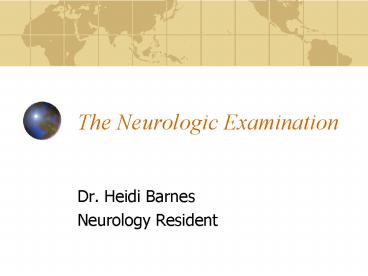The Neurologic Examination - PowerPoint PPT Presentation
1 / 13
Title:
The Neurologic Examination
Description:
The Neurologic Examination. Dr. Heidi Barnes. Neurology Resident. Anatomic Localization ... Neurology examination tests for those clinical signs ... – PowerPoint PPT presentation
Number of Views:992
Avg rating:3.0/5.0
Title: The Neurologic Examination
1
The Neurologic Examination
- Dr. Heidi Barnes
- Neurology Resident
2
Anatomic Localization
- Every anatomic location has unique clinical signs
- Neurology examination tests for those clinical
signs - You must perform and interpret the examination
properly to have it help!
3
Rostral to the Foramen Magnum
- Cerebrum/telencephalon
- Thalmus/diencephalon
- Midbrain/mesencephalon
- Pons/metencephalon
- Medulla oblongata/myelencephalon
- Cerebellum/part of metencephalon
4
Lesion Localization
- Telencephalon/Diencephalon
- Mentation changes depression, dementia, stupor,
coma - Seizures (ALWAYS!!!)
- Basal Ganglia LIMITED (cerebrospinal tracts)
motor to limbs. - Horse lips, face
- Dog Upper forelimbs
- Cat Complete forelimbs
- Human/Chimp hands
- Circling toward lesion, NO head tilt!
- Blindness intact PLR, no menace
5
Localization for the Brainstem
- I. Olfactory
- II. Optic
- III. Oculomotor
- IV. Trochlear
- V. Trigeminal
- VI. Abducens
- VII. Facial
- VIII. Vesibulocochlear
- IX. Glossopharingeal
- X. Vagus
- XI. Spinal Accessory
- XII. Hypoglossal
Motor tracts (red nucleus, reticulospinal tracts)
cross in midbrain.
6
Cranial Nerve Evaluation
- Ear/lip/eye twitch V and VII
- Temporal/masseter muscle V
- Gag IX and X
- Trapezius muscle XI
- Tongue movement XII
- Menace II and VII
- PLR II and III (parasympathetic part)
- Strabismus
- Static III, IV, VI
- Positional VIII
- Nystagmus VIII
7
Spinal Cord Localization
- Divided into cord segments based on the anatomic
action - Upper motor neuron cell body originating rostral
to the foramen magnum - Lower motor neuron cell body originating in the
spinal cord
8
Spinal Cord Segments
- C1-C5 Upper Motor Neuron all 4 limbs
- C6-T2 Lower Motor Neuron front limbs
- Upper Motor Neuron pelvic limbs
- T3-L3 Upper Motor Neuron pelvic limbs
- L4-S3 Lower Motor Neuron pelvic limbs
L4-S3
C1-C5
T3-L3
C6-T2
9
Postural Reactions Upper Motor Neuron Function
- Hopping, placing, conscious proprioception
- Need lower motor neurons intact
- BUT also uses white matter of spinal cord
10
Reflex Arch- Lower Motor Neuron Function
11
Spinal Reflexes Thoracic Limb
- Biceps brachii musculocutaneous
- Triceps radial nerve
- Extensor Carpi radialis radial nerve
- Withdrawal axillary median/ulnar
musculocutaneous radial
12
Spinal Reflexes Pelvic Limb
- Patellar Femoral (L4-5)
- Sciatic Sciatic (L6-S2)
- Cranial tibial peroneal (L6-7)
- Gastrocnemius tibial (L7-S1)
- Withdrawal Sciatic (L6-S2)
Withdrawal is not conscious!!
13
Practice Makes Perfect































